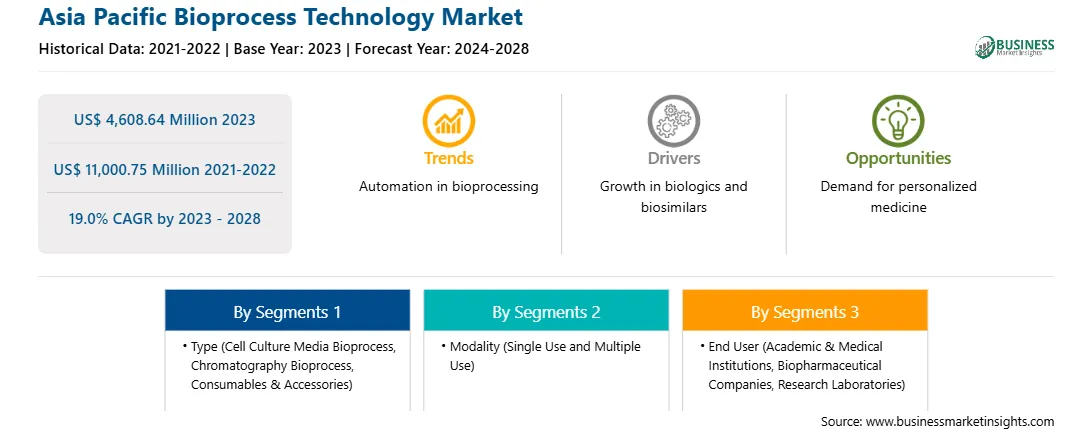亚太地区生物工艺技术市场预测至 2028 年 - COVID-19 影响和区域分析 - 按类型(细胞培养基生物工艺、色谱生物工艺以及耗材和配件等)、模式(一次性和多次使用)和最终用户(学术和医疗机构、生物制药公司、研究实验室等)
No. of Pages: 141 | Report Code: BMIRE00028868 | Category: Life Sciences
No. of Pages: 141 | Report Code: BMIRE00028868 | Category: Life Sciences
流式细胞术 (FCM) 及其技术可能性在过去十年中取得了巨大进步,作为生物反应器中单细胞特性和不同细胞类型群体分布的分析工具。在此过程中,开发了一些自动化实时流式细胞术(ART FCM)解决方案,用于监测生物反应器过程,而无需操作员长时间干扰,并具有可变的采样频率。 ART FCM 可以实现长期测量,不会遗漏生物过程中的任何重要事件,并揭示可能未知且应进行更详细研究的时间现象。此外,可以按照用户定义的频率执行更频繁的测量,而与人员的可用性无关。与仅在单细胞水平上部分可用的组学等方法相比,通过 ART-FCM 可以轻松建立多参数测量,而无需花费大量的人力和时间。与传统的 FCM 研究相比,微流控设备作为 ART 芯片上的 FCM 具有巨大的未来潜力。在这种情况下,并行化可能变得更加相关,因为可以同时分析来自不同生物反应器或生物反应器设置内不同位置的样品。许多方面也可能适用于其他实验装置,其中荧光过程参数的快速且可重复的实时监测也令人感兴趣。总之,ART’FCM 在未来几年很可能会呈指数级增长。
根据 BioPlan Associates 1000 强生物设施指数和生物制造商数据库报告,自过去十年以来,全球生物加工能力平均增长了 12%。中国作为小分子药物和大分子药物市场的全球参与者处于有利地位,分别占据全球第二和第三位。此外,由于中国拥有合同开发和制造组织 (CDMO) 基地,约占该国生物产能的 25%,中国也是多家细胞和基因治疗开发商的所在地。因此,中国拥有相当大的生物制造能力,但严格遵守全球 GMP 标准,这增强了人们对生物制品安全性和有效性的信心。
< strong>亚太地区生物工艺技术市场细分
亚太地区生物工艺技术市场按类型、模式、最终用户和国家/地区进行细分。
根据类型,亚太地区生物工艺技术市场分为细胞培养基生物工艺、色谱生物工艺、耗材和生物工艺。配件等。 2023年,耗材及产品配件细分市场在亚太生物工艺技术市场中占据最大份额。
根据模式,亚太生物工艺技术市场分为一次性和多次使用。到 2023 年,一次性用途细分市场在亚太生物工艺技术市场中占据更大份额。
根据最终用途,亚太生物工艺技术市场分为学术领域&医疗机构、生物制药公司、研究实验室等。 2023年,生物制药公司在亚太生物工艺技术市场中占据最大份额。
按国家划分,亚太生物工艺技术市场分为中国、日本、印度、澳大利亚、韩国和亚太其他地区。 2023年,中国市场在亚太生物工艺技术市场中占据最大份额。
康宁公司;丹纳赫公司;艾本德公司;龙沙集团股份公司;默克公司;雷普利根公司;赛多利斯公司;和 Thermo Fisher Scientific Inc 是亚太生物工艺技术市场的领先公司。
Strategic insights for Asia Pacific Bioprocess Technology involve closely monitoring industry trends, consumer behaviours, and competitor actions to identify opportunities for growth. By leveraging data analytics, businesses can anticipate market shifts and make informed decisions that align with evolving customer needs. Understanding these dynamics helps companies adjust their strategies proactively, enhance customer engagement, and strengthen their competitive edge. Building strong relationships with stakeholders and staying agile in response to changes ensures long-term success in any market.

| Report Attribute | Details |
|---|---|
| Market size in 2023 | US$ 4,608.64 Million |
| Market Size by 2028 | US$ 11,000.75 Million |
| Global CAGR (2023 - 2028) | 19.0% |
| Historical Data | 2021-2022 |
| Forecast period | 2024-2028 |
| Segments Covered |
By 类型
|
| Regions and Countries Covered | 亚太地区
|
| Market leaders and key company profiles |
The regional scope of Asia Pacific Bioprocess Technology refers to the geographical area in which a business operates and competes. Understanding regional nuances, such as local consumer preferences, economic conditions, and regulatory environments, is crucial for tailoring strategies to specific markets. Businesses can expand their reach by identifying underserved regions or adapting their offerings to meet regional demands. A clear regional focus allows for more effective resource allocation, targeted marketing, and better positioning against local competitors, ultimately driving growth in those specific areas.

The Asia Pacific Bioprocess Technology Market is valued at US$ 4,608.64 Million in 2023, it is projected to reach US$ 11,000.75 Million by 2028.
As per our report Asia Pacific Bioprocess Technology Market, the market size is valued at US$ 4,608.64 Million in 2023, projecting it to reach US$ 11,000.75 Million by 2028. This translates to a CAGR of approximately 19.0% during the forecast period.
The Asia Pacific Bioprocess Technology Market report typically cover these key segments-
The historic period, base year, and forecast period can vary slightly depending on the specific market research report. However, for the Asia Pacific Bioprocess Technology Market report:
The Asia Pacific Bioprocess Technology Market is populated by several key players, each contributing to its growth and innovation. Some of the major players include:
The Asia Pacific Bioprocess Technology Market report is valuable for diverse stakeholders, including:
Essentially, anyone involved in or considering involvement in the Asia Pacific Bioprocess Technology Market value chain can benefit from the information contained in a comprehensive market report.